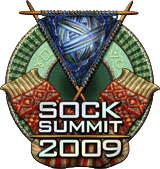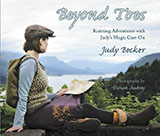The other day, Amy asked a question that comes up all of the time, so I thought I would post an answer because I know that others have this same question.
In the first picture, you can see a sock toe. This toe was knit with some unknown stash yarn on Knit Picks size US#1 needles. I cast on 10 stitches on each needle using Judy’s Magic Cast-On. Then I increased every other row. The increases were worked 1-stitch in from each side.
You can see that the increases have pulled the toe up on the sides and made little mouse ears stick up on the corners. (I’m very tempted to use the magic of photoshop to add little eyes and a little nose to that sock toe…) The toe looks very straight and boxy.
Many knitters, when faced with little mouse ears on their sock toes, try to alleviate the problem by pulling the cast on and the next few rounds tighter. And that only makes it worse. Although it doesn’t seem intuitive, what really solves the problem is loosening up.
Let’s look at this second picture: same yarn, same needles, same techniques used. The only difference is that I cast on loosely. You can see that the little ears, rather than sticking up on top, lie nicely close to the toe and make a smooth, slightly rounded end.
Why does this make such a difference? Let’s talk about what’s happening here.
The increases pull the stitches on the sides of the toe out of alignment with the other stitches and make them march in a new direction. The point where the first increases are made is sort of like a one of those wonky intersections where streets converge at all angles. The stitches are all trying to go off in different directions, and they pull on each other a bit as they jostle for position.
In the first picture, the cast-on stitches are so tight that they have no give. They can only lie straight in one direction. As the edge stitches try to change direction and march sideways at an angle, the rigid end stitches pull on them. The only direction the poor corner stitches can go is up. So they become little ears.
In the second picture, the cast-on stitches are looser, so they can move around a bit. They help out the edge stitches by leaning very slightly towards the sides and curving upwards into a slight arc. This allows the corner stitches to relax and lie next to their neighbors instead of being pushed out of position.
It can be tough to loosen up when using a new technique. And JMCO seems particularly suited to being worked very tightly, in contrast to some of the other toe-up cast-ons which are loose and have to be tightened up later. Here are a few suggestions to help keep the mousies away:
- Use a size larger needles to do the cast-on, then knit the first round using the smaller size. If it still looks tight, also knit the first round with the larger size and switch to the smaller size on the first increase round.
- Try increasing two stitches in from the edge instead of one stitch. Having a larger section marching a new direction can help to mask any tension problems. But sometimes you might end up with elephant ears.
- Try a different increase. Look for an increase that doesn’t distort the stitches around it, or distorts them less. One to consider is a YO that’s knit twisted on the next round by knitting into its back loop. Twisting the YO closes the hole that it would normally make, and this increase can be made every round.
- Increase every round for the first 4 or 5 rounds, and then every other round for the rest of the toe. Having more stitches marching together can help everyone to line up nicely.
- Decide that mouse ears are cute and nobody is going to see your sock toes in your shoes anyway. (yes, this is a legitimate approach)
Hope this helps!
P.S. Thanks for all of the suggestions on what the German Mystery Yarn might be. I’m so thrilled that #1 Son brought yarn back that I’m happy as a clam with it, whatever it is.


 feed for comments on this post.
feed for comments on this post.























Thank you for this enlightening post!!! The mouse ears have been plaguing me lately, and I kinda figured I was too tight.
1Remark from akimbo — Monday, 7/28/2008 @ 8:53 AM
I just recently started noticing the mouse ears…I don’t think when I started using the cast on that I was knitting as tightly…now? Oh yeah. I know what I’m doing, don’t have to resort to diagrams and as such am knitting at my regular tension.
2So…I’ll try the larger needle first!
Thank you!
Remark from Knitnana — Monday, 7/28/2008 @ 10:27 AM
Thank you!!! 🙂 You nailed my problem right on the head. I’m a tight knitter and it gets worse when I’m knitting something like a sock toe that I REALLY don’t want to wind up falling apart because it’s too loose.
Yet another piece of my knitting repertoire for me to fine-tune Once the socks were finished, I was able to tweak the “mouse ears” on the Black Socks of Doom down to a manageable level. Hubster’s huge black socks will no longer resemble the Mickey Mouse Ears hats everyone wears at Disneyland!
Once the socks were finished, I was able to tweak the “mouse ears” on the Black Socks of Doom down to a manageable level. Hubster’s huge black socks will no longer resemble the Mickey Mouse Ears hats everyone wears at Disneyland!
3Remark from amy — Monday, 7/28/2008 @ 11:43 AM
Well done, Judy – and this just adds evidence for my case that you should write a knitting book – how about the Knitting Doctor?
4Whatever you do it will be great.
Interesting comments on the German yarn – I knit while I was in Holland as an exchange student (maaaany years ago) but I have no recollection of actually buying the yarn.
Remark from Pat Martin — Monday, 7/28/2008 @ 8:03 PM
Thank you for the post. I am so new to socks that I did not know this was a problem. 😆 Now I have fixed it.
5Remark from Heather — Friday, 8/1/2008 @ 10:13 PM
Very informative and helpful. I always wondered why some of my socks had “mouse ears” and others didn’t. Now I know.
6Remark from ~Kristie — Wednesday, 8/6/2008 @ 4:55 PM
How did you take a picture of my sock? 😯 I kept telling myself it was my first one. 😳 Thank you for the tips for the second one.
7What is your favorite M1 method ❓
Remark from mary — Tuesday, 8/19/2008 @ 8:41 PM
So are you on vacation from work AND the blog?? wondering if all is ok…..you have been absent before but just wondering??
8Remark from Susanne — Saturday, 8/23/2008 @ 7:40 PM
Thanks for the tip on the mouse ears – i didn’t even realise i had a problem till you pointed it out.
But now you mention it….I will try casting on more loosely next time – I use your technique of course.
Many thanks, as always.
Alison :
PS the socks I knitted from your tangled up in blue pattern have become my favourite pair. I wear them with boots, shoes and trainers, and around the house and to bed. They were my first toe-up socks, and the fit is great.
I started another pair using a different pattern because |I wanted to try a short row heel, not realising the sock would not have a proper heel gusset. I have completed the foot and an inch or so of the cuff, and I do not like the heel at all. The fit feels tight where the foot bends (I’m sure there is a correct anatomical term). I will probably frog that one, and knit using the tangled up in blue as a basic pattern, perhaps adding a lace panel up the front. I’ll let you know the result
Thanks again for your very clear instructions.
9Remark from Alison from the UK — Friday, 9/5/2008 @ 4:46 AM